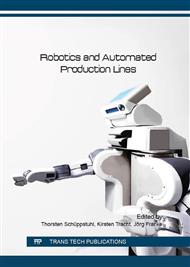p.1
p.8
p.16
p.24
p.33
p.42
p.50
p.58
p.66
Identification of Assembly System Configuration for Cyber-Physical Assembly System Planning
Abstract:
To respond to challenges created by an increase of product variants, multi-variant lines are used as today’s assembly systems. In these multi-variant lines different product variants with diverse lot sizes can be efficiently assembled. These assembly systems are characterized by modular structures that allow assembly system adaptation by reconfiguration.The variety of parameters to be considered from the product’s perspective and the correct allocation of different assembly modules increases the complexity when planning these systems. This complexity makes it difficult to successfully plan and implement production processes. Therefore, digital planning tools and models have to be used to schedule new product variants and to verify that the assembly is possible, given by the modules in the assembly line.Due to its ability to reconfigure, the actual assembly system is adaptable to different product variants. But these modifications are performed by the operator on the shop floor and are often neither properly documented nor communicated to the assembly planer. Thus, the configuration status in reality and the virtual model differ from each other. Using the outdated model for planning without taking into account the changes can result in an unrealizable assembly plan.To overcome this problem, the presented paper introduces a method and technical system to identify the actual assembly system configuration before the assembly planning is done. Due to the subsequent update of the virtual model depending on the actual configuration, the assembly planner is supported with the latest version of the assembly system configuration. Furthermore, the assembly planning process is improved, because possible failures are detected in advance in the virtual planning environment.
Info:
Periodical:
Pages:
24-32
Citation:
Online since:
June 2016
Authors:
Price:
Сopyright:
© 2016 Trans Tech Publications Ltd. All Rights Reserved
Share:
Citation:


